This article is derived from a more expansive work that can be found here.
How does becoming a lawyer change you? After taking the LSAT, soliciting recommendations, writing personal statements that narrate your life and purpose for pursuing law, perhaps moving to a new city, and finally enrolling in a program often at great financial expense, you enter a classroom that may at first look familiar. But appearances can be deceiving. This will be unlike prior educational experiences. Here you are to be initiated into a professional fellowship. You will be instilled with a training that offers both new privileges and new obligations. You will be expected to adhere to a new set of norms. In many respects, you are to embody a professional self. You may feel ready and willing to be molded into a prestigious new role, or apprehensive about your loss of freedom as you commit to a career path. You may feel insecure about your ability to succeed. You are likely uncertain about exactly how this will all unfold. What will come of your ideals? Who will you be at the end of this program?
Since 2008, I have been examining professional identity formation through a multi-method, qualitative study of law students’ experiences at a major law school in the United States. For this issue of The Practice, I focus primarily on the first two years of law school as students make their first substantive contact with the legal profession. The sample is drawn from an elite U.S. law school with a strong public-interest reputation. This site brings the dynamics of political ideals and job paths into sharp relief, as many students place a strong initial emphasis on public-interest career plans, but are offered relatively easy access to positions in large law firms. Through interviews, identity mapping, and ethnographic observations, this analysis considers how professional socialization alters not only career goals of lawyers-in-training, but also the fundamental machinery of identity construction—constitutive roles, narratives, and normative commitments.
The Takeaway
Among the law students interviewed for this study, experiences of professional identity varied strongly by students’ job-decision paths during law school. Students who pursued public-interest careers generally maintained a central conception of lawyer identity, which often overlapped with political, racial, religious, and gender roles. In contrast, students who pursued positions in large firms tended to describe substantial distancing from professional identity in their 2L interviews. For students who had initially stated a preference for positions in the public-interest sector but later decided to pursue large firms, this distancing was often accompanied by a distressing sense of temporariness and fraudulence in their professional identities. This raises questions as to whether we can—and whether we should—foster a more integrated conception of professional identity among new corporate lawyers.
I examine students’ experiences largely through the lens of Erving Goffman’s classic sociological concept of “role distancing.” For Goffman, we construct ourselves by managing the roles we enact in our daily lives. For example, you may wish to occupy such diverse roles as lawyer, parent, driver, pedestrian, customer, and member of your local civic association. Other roles may draw on a sense of national, political, racial, religious, gender, and other social identities. In Goffman’s account, we conceive of these roles on a spectrum of identification. Some roles we “embrace” or experience in a proximate and centrally constitutive manner. When we enact these roles, to use Goffman’s words, we “disappear into the virtual self available in the situation.” In contrast, we view other roles with more detachment. Borrowing Goffman’s words again, we approach these roles with “a pointed separateness between the individual and the role.” This is often a reflection of our internal aversion to the behavior required by the role.
Where do new lawyers locate their professional identity among the other roles in their lives? More specifically, how does the law student’s conception of his or her professional role shift during the law school experience? As I lay out below, my analysis suggests a strong association between a student’s initial job-path decision and ultimate views on professional identity. How law students construct their professional identities—and how these identities are influenced by wider professional and social norms and structures—is critical to understanding lawyers’ career satisfaction and the civic contributions of the legal profession.
Research methodology
The big methodological challenge in discussing questions of identity is that “identity” is an analytically complex concept as well as a deeply personal phenomenon. Fortunately, in conducting this research I found that law students and lawyers are often highly reflective and articulate about their personal and professional identities, if they are made to feel comfortable and if the issues are approached from multiple angles. To help the people I was interviewing conceptualize their own identity structures, I used an identity mapping exercise combined with narrative interviews (see “Identity mapping” box).
Drawing on mapping strategies in social psychology, this method is designed to provide visualizations of role alignments and to reveal identity processes that are not easily verbalized. I ask the respondents to carefully consider the placement of each role, so that I can visually compare maps over time and across population variables. These maps are also amenable to aggregate analysis, as I discuss below. However, the richest data from this method comes from the interpretive conversations following the exercise, in which I discuss with the respondent what the labeling and placement of each role category means to them.
Identity mapping
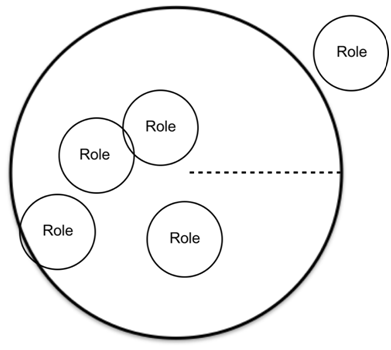 The identity mapping method described above was introduced roughly 30 minutes into each interview. I presented interviewees with a large circle, with a defined radius, meant to visually represent their identity. Other than the large circle, the paper was blank. I then asked the interviewees to draw and label small circles within the larger circle, each of which represented the roles that they enact in their daily lives. I also instructed the interviewees to place those roles in the position that most accurately reflects how strongly each contribute to their personal sense of self—the closer to the center for roles with which they strongly identify and the further from the center for roles they consider more distant. The only role that respondents were specifically asked to include was their anticipated lawyer identity.
The identity mapping method described above was introduced roughly 30 minutes into each interview. I presented interviewees with a large circle, with a defined radius, meant to visually represent their identity. Other than the large circle, the paper was blank. I then asked the interviewees to draw and label small circles within the larger circle, each of which represented the roles that they enact in their daily lives. I also instructed the interviewees to place those roles in the position that most accurately reflects how strongly each contribute to their personal sense of self—the closer to the center for roles with which they strongly identify and the further from the center for roles they consider more distant. The only role that respondents were specifically asked to include was their anticipated lawyer identity.
Several interesting features of these identity maps became salient. My primary focus was on the placement of each role—the measured distance in centimeters away from the center of the identity circle. I also found compelling qualitative data relating to what roles respondents included, how they labeled their roles (e.g. lawyer versus advocate), whether their roles were overlapping or separated, and how they used arrows and explanatory notes to discuss the relationship among the roles in their lives. Below you can see a sample identity map. You will see the actual identity maps from my interviewees in the analysis that follows.
Perspectives on professional identity
Professional role distancing has been a central concern in the normative literature on U.S. lawyers. The standard conception of lawyer identity is that it requires “thin professional identity,” whereby lawyers bifurcate between personal values and professional behavior in accordance with a client-centered principle of neutral partisanship. Defenders of the standard conception emphasize that it is necessary to avoid role confusion and paternalism in interactions with clients. It is important to note that within this line of thinking, scholars often stress that thin professional identity need not be alienating, as lawyers can take pride in providing client-service without individual moral screening.
Critics of thin professional identity worry that it encourages a “bleached out professionalism,” which is neither desirable nor realistic. Thus, the “thick” account of professional identity argues that lawyers should be public professionals, officers of the court, purposivists, and lawyer-statesman—not amoral technicians. On the far end of the thick professional identity continuum is the cause-lawyering perspective. Cause lawyers reject thin professional identity and explicitly invest the professional role with the lawyer’s own political values and goals.
Can a good lawyer be a good person?
Furthermore, some legal theorists have argued that the lawyer role is fundamentally morally flawed, as lawyers are required to engage in “moral prostitution” by selling their “words, thoughts, and convictions” to the client. These critics worry that the detachment implied by the standard thin conception leads to the atrophy of lawyers’ moral faculties. This concern raises the perennial question about the lawyer’s role-differentiated morality: Can a good lawyer be a good person? (See “What is Good in Law and in Life.”)
In this normative debate, scholars often lament the lack of empirical research on how lawyers actually relate to their professional identity. The nearest empirical literature is a series of sociological studies examining legal training, particularly focusing on the 1L classroom. These studies generally suggest that students are inculcated in the thin account of professional identity, much to their detriment. Through the Socratic exchange of the law school classroom, students are presented with a new legal epistemology—they learn to “think like a lawyer.” In this process, they learn to eschew their initial moral, emotional, and political reactions to cases in favor of doctrinal analysis, and to privilege legal context over social context. Students transition from a justice-oriented to a game-oriented consciousness and from a vocabulary emphasizing social justice to one that emphasizes zealous advocacy for one’s client irrespective of the client’s ends.
This literature has also focused on the experiences of progressive law students who may be alienated during law school and experience “public interest drift”—a process in which they begin their legal education with a preference for careers in public interest positions (e.g. legal aid, public defender), but within the first year of their legal education are re-oriented and “drift” to pursuing careers in private sector positions, such as law firms.
These studies examine the implicit lessons of legal pedagogy, but they place less emphasis on how students internalize those lessons within their ongoing identity processes. This is the gap that motivates my research.
Three typical identity paths of law students
My analysis of law students’ professional identities suggests three identity types, corresponding to three typical job paths:
- Government or public-interest path. Students committed to careers in “government or public interest” (“GPI”) tended to report highly integrated professional identities that changed little over the course of their legal education. On their identity maps, these respondents tended to place the anticipated professional role in a central cluster, while the law student role was located on the periphery.
- Corporate path. In contrast, corporate-path students—those who stated a preference from the beginning of law school to work in large corporate law firms—tended to report a substantial and increasing bifurcation between central personal roles and the peripheral lawyer role. In aggregate, these respondents experienced a more proximate relationship to the law student role.
- Drifting path. The third category represents students who “drift” from a GPI trajectory to a private-firm trajectory. Between the first and second years of law school, drifting-path respondents often experienced a pronounced shift as the “professional” role moved toward the periphery of their self-conceptions. These respondents maintained a distant placement of the law student role. The drifting category was marked by feelings of fraudulence as respondents struggled to maintain temporary role performances as corporate lawyers while reporting moral and psychological reservations about their anticipated jobs.
Below I provide identity maps and interview excerpts to elaborate on observations regarding each of these three paths.
The GPI path: professional role integration
Figure 1 is an identity map from Laura, a second-year law student who reported that she hoped to begin her post-graduation career in a non-profit setting working on death penalty appeals or indigent defense. We will return to several other aspects of Figure 1, but I want to begin by focusing on Laura’s central placement of the lawyer role—labeled “good advocate”—which is surrounded by an equidistant cluster of highly personal roles (“Catholic,” “me being a family member,” and “Latina”). In this respect, Laura instantiates my aggregate finding that GPI path respondents, in both their first and second years of law school, tended to place the lawyer role in a central position that is tightly integrated with their other constitutive roles. This finding is roughly consistent with the cause-lawyering perspective in which lawyers strive to, as Stuart Scheingold and Austin Sarat write in Something to Believe In, “overcome alienation with belief and to break down the barriers between vocation and commitment.”
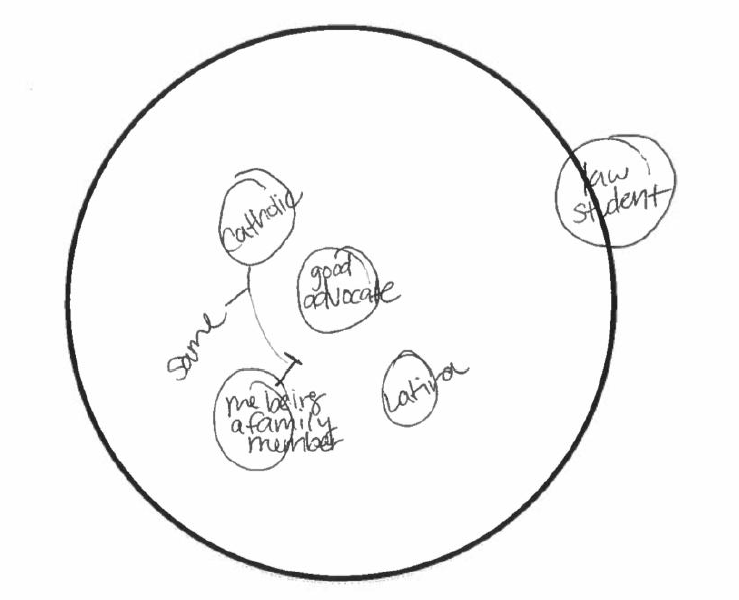
In our interpretive dialogue following the mapping exercise, Laura acknowledged a tension between her conception of professional role integration and the lessons she received in law school regarding the bifurcated nature of the conventional lawyer role:
Central is ‘advocate,’ which is not necessarily an attorney. Just like an advocate for the communities that I care about, which includes minority communities, lower-income communities, and maybe particularly people who are in prison or who are part of the criminal justice system in some way. But I also think part of being an advocate will be being a lawyer, but I think being a lawyer I’ll be pissed off. . . . I won’t be able to say everything I want to say in my personal life.
GPI respondents frequently used alternative labels for the lawyer role. In addition to Laura’s use of “advocate,” other respondents labeled their professional identity as “activist” or “public interest career.” These respondents generally reported that they reject the narrow legal definition of client-centered advocacy, instead conceiving of advocacy more broadly as promotion of a social movement by legal and extralegal means—what might be described as “social advocacy” in contrast to “legal advocacy.” Several GPI respondents even included the word “law” as a role identity on their maps and placed it on the far periphery. This skepticism regarding the “law” in “lawyer” reflects a highly political sense of professional purpose and a partial rejection of the limitations attached to the conventional lawyer role. Below I provide an empirical portrait of professional role integration and its limitations and exceptions. While these findings primarily arise from qualitative analysis, they are also illustrated with aggregate map data (Figure 2).

Figure 2 shows relative aggregate consistency between the first and second year across most roles. The lawyer role—labeled “advocate” in the aggregate map to reflect the common substitutions for “lawyer”—moved slightly outward from the center, but was not ejected to the periphery as in the aggregate corporate- and drifting-path maps discussed below. For many GPI respondents, not only are the bulk of their role identities at a similar distance from the center, but they are physically overlapping. Brian, a GPI student in his second-year, exhibited this overlap to an extreme (Figure 3).
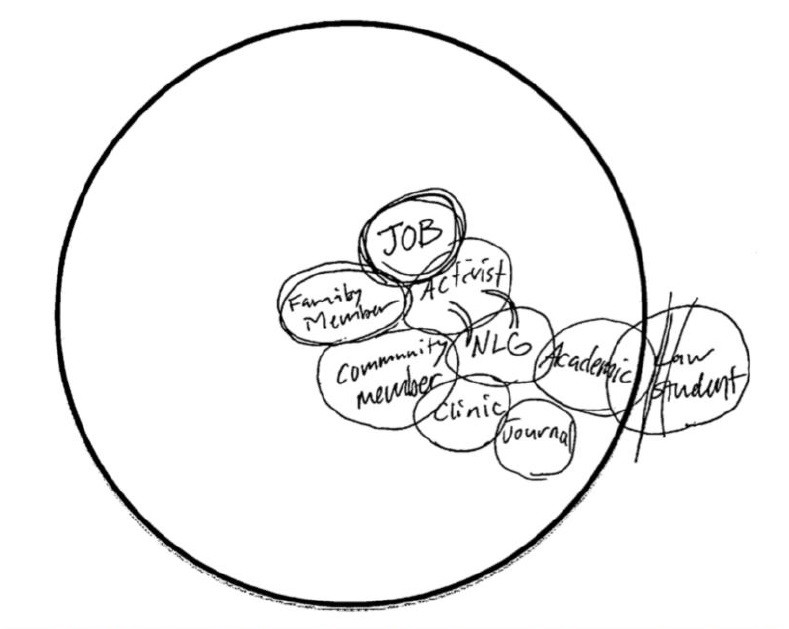
Consistent with this description of overlapping and clustered roles, GPI respondents often reported that their professional motivations are rooted in racial, gender, political, religious, community, and family roles. As Brian explained, his integrated experience of professional identity reflects his family’s progressive political orientation:
“Everything is definitely tied up with my role as a family member since my family is really defined by being activists and community members.” Later in the interview, he extended this concept of family support to his home community: “My friends, the community that I’ve grown up with, these people are all so proud of me back at home for getting into this law school and for pursuing my dream of being that social-justice advocate.”
The political component of Brian’s professional role integration is evidenced by the overlap of “job” with “activist” and “NLG” (National Lawyers Guild, a progressive association of public-interest law students and lawyers) in his identity map. As discussed in the following sections, the centrality of political roles among second-year GPI respondents diverges markedly from the other two job paths. This distinctly politicized and non-bifurcated professional identity is consistent with the view of cause lawyers in the literature. As Scheingold and Sarat observe: “Moral and political commitment, the defining attributes of cause lawyers, are, for most of their peers, relegated to the margins of their professional lives.”
Everything is definitely tied up with my role as a family member. My family is really defined by being activists and community members.
Brian, a GPI student in his second-year
It is important to note that there is diversity within “public interest practice.” Many respondents whom I classified in the GPI path pursued what they often called “middle road” public-interest careers, such as positions in government or in a plaintiff-side law firm. These respondents often described this work as only partially aligned with their political values while providing better income and job security when compared to legal-aid or nonprofit organizations. I speculate that these respondents tend to experience a slightly less central and politicized professional role than those intending to work in the nonprofit sector as card-carrying “cause lawyers.”
The corporate law path: professional role distancing
The corporate law path consists of respondents who stated a preference for large-firm jobs in both their first and second year of law school. Relative to the GPI path, these respondents, particularly as second-year law students, tended to view their upcoming legal positions as instrumental and distant from what they conceived as their core identities. In contrast to the drifting path experience, corporate-path respondents generally expressed few qualms about this compartmentalization. These themes are evident in Sam’s second-year identity map (Figure 4), where he explained that “lawyer” is placed on the far periphery because, “I came to law school to get a job.”
I came to law school to get a job.
Sam, a 2L corporate path student
Thus, unlike the GPI respondents cited above, Sam described the lawyer role as distinct and distant from other constitutive identities, such as religious, political, and familial roles. Family is his most central role, including both his existing family roles—“family (old)”—and his intention to have children in the near future—“family (new)”. Citing the recession, he also reported that his financial instrumentalization of the lawyer role is driven by “self-preservation” in a period of widespread financial uncertainty.
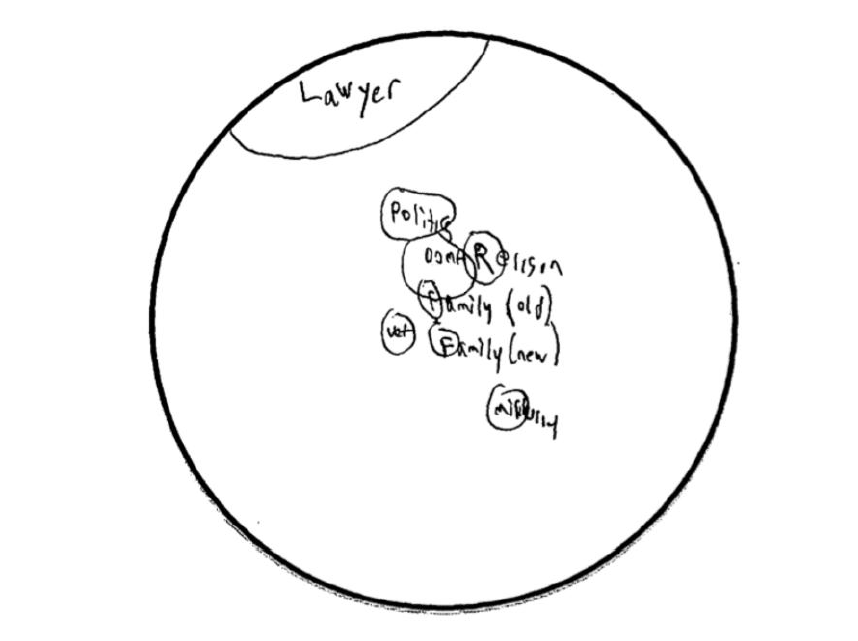
As we saw earlier, GPI respondents tended to locate the professional role in the center of their identity maps, while placing the law-student role on the periphery. The aggregate corporate map shows the opposite pattern. Between the first and second year of law school, “lawyer” moved toward the outer edge of the identity space, while “law student” remained relatively central. The aggregate political, racial, religious, and gender roles appear somewhat further from the center than those found in the GPI path. Consistent with the peripheral placement of these roles, corporate path maps tend to be characterized by greater compartmentalization (fewer overlapping roles) in contrast to the characteristic overlap found in the GPI path.
Corporate path respondents tended to describe a more bifurcated conception of the lawyer role in sharp contrast to the cause-lawyering picture of a personalized and politicized professional identity (Figure 5). A second-year corporate path respondent explained: “Even things that I’m passionate about in the law are secondary to me. I’m ok with that…[Being a lawyer] is not central to my being at all. I want to be a lawyer just so that I can provide for the things that I want out of life.”
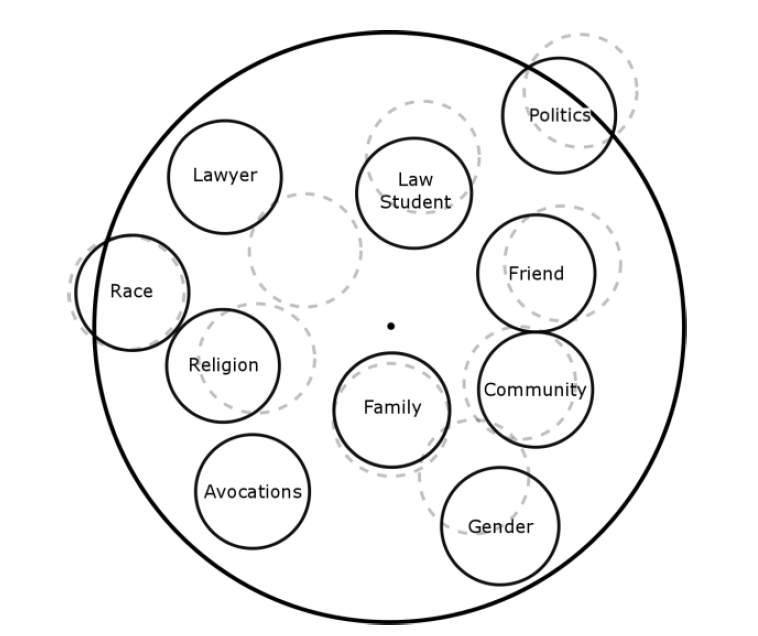
Most corporate path respondents described their upcoming jobs at law firms as a temporary step in a long-term career plan. A second year corporate-path respondent explained: “The only reason I’m going to a firm is to get that nest egg…and to get the training, to get that line on my resume.” Mobility plans often included an eventual exit from the large-firm sector or the legal profession all together (see “Drawing Your Own Path”), as the following first-year corporate-path respondent explained:
I plan to be a lawyer for however long it takes to do something else. It’s more of a launching pad for me. Step 1: Go to law school. Step 2: Pay off massive debt. Step 3: Get out of massive law firm and pursue other opportunities like smaller firms or business.
Corporate path maps tend to be characterized by greater compartmentalization (fewer overlapping roles) in contrast to the characteristic overlap found in the GPI path.
This temporariness in the large-firm lawyer role does not appear to be rooted in moral distancing from professional activities, as described among drifting respondents below. Instead corporate-path respondents tended to view temporariness as a highly beneficial aspect of large-firm employment. The notion that these students will pay down their loans within a few years of firm practice and then move to different jobs and even different sectors is well supported by the After the JD data. By the seventh year, half of elite-school graduates who began their careers in large firms had moved to other practice settings.
Most corporate-path respondents also admitted an element of “sacrifice” in their conception of their anticipated lawyer roles. As one interviewee put it, “[Associates in large firms] make an obscene amount of money to do fairly remedial things in their first couple of years. You’re selling your time.” But these conceptions of sacrifice generally were not accompanied by the self-shaming accounts of “selling out” found among drifting respondents. A second-year corporate path respondent explained:
You should never sell your soul, but you certainly [can] rent it. I’ll rent them my soul for you know, a couple hours, or you know, a couple years of my life, if it means that I get to have a good quality of life for the rest of it.
Several corporate-path women and two men (including Sam, Figure 4) explained that the lawyer role was peripheral because they worried that their work life might encroach on their plans to have children. A first-year corporate-path respondent explained:
I want [being a lawyer] to be a central thing in my life because it’s going to probably be where most of my waking hours are, but I don’t ever really want to be in a position where my job subsumes me, and I don’t think it will. I’ve wanted to be a parent since I was a very little kid…and I can’t really see the job subsuming that…I think that’s going to be a real tension point for me.
Some respondents explained that they would prefer to enact a more central lawyer role, because a deep investment in their professional identities might improve their chances at upward career mobility, but they felt that their plans to have children were incompatible with professional role embracement. A first-year, female corporate-path respondent told me, “The truth of the matter is, if I have a kid I’m never going to be as, well ‘successful’ is the wrong word, but I’m never going to be able to gun as hard as someone who doesn’t. And that is a trade-off you make.” As one might expect, these concerns were often directly tied to gender. As a second-year, female corporate-path respondent explained:
Women can’t have it all. That’s how it works. You’re not going to have it all if you want to do everything well. You have to decide what your priority is and for me it’s my family…So if [the lawyer role] starts moving in towards the middle then that’s going to be a problem.
You should never sell your soul, but you certainly [can] rent it. I’ll rent them my soul [for] a couple years of my life if it means that I get to have a good quality of life.
These accounts resonate with previous empirical studies of law firms and other professional settings where women face heightened levels of work-family conflict and greater penalties for having children. In the large-firm sector, women are increasingly represented among new associates but experience far less representation among partners. A leading explanation for this persistent inequality has been that the partner track was built on a traditional white male model, drawing heavily on forms of symbolic capital that disadvantage women and relying on an understanding that lawyers have a stay-at-home spouse who manages their non-work life. This traditional model is organized under an assumption of total work devotion. Several female corporate-path respondents anticipated these limitations. One respondent reported that she learned during a call-back interview with a large firm that the only way for women who have children to advance to partnership was to have their spouse stay home. “Literally any women in that office who had made partner and had a child, their husbands were house husbands,” she told me. “They literally did not work at all, because of the strain of her career.”
This respondent felt that asking her husband to stop working was not an option. This trend is corroborated by the After the JD study, which finds that women are more likely to report that they had left law firm practice in order to care for children. For some women in the corporate path, expectations of gender discrimination may limit work devotion, which can contribute to experiences of professional role distancing.
The drifting path: professional role distancing and fraudulence
The drifting path consists of respondents who, between the first and second years of law school, shifted from a preference to begin their legal careers in the public-interest sector to an intention to begin in the large-firm sector. As Figure 6 illustrates, Sara, a second-year drifting-path respondent, planned to begin her career in “Big Law” (at a large corporate law firm) and then, after a few years, to “hopefully” return to the public-interest sector as a “civil rights lawyer.” Sara explained that her anticipated civil rights position would be a more proximate professional role than her anticipated “Big Law Firm Job,” which she placed entirely outside the identity circle. She described the opportunity to work in Big Law as a necessary sacrifice given the scarcity of job opportunities and her substantial student debt.
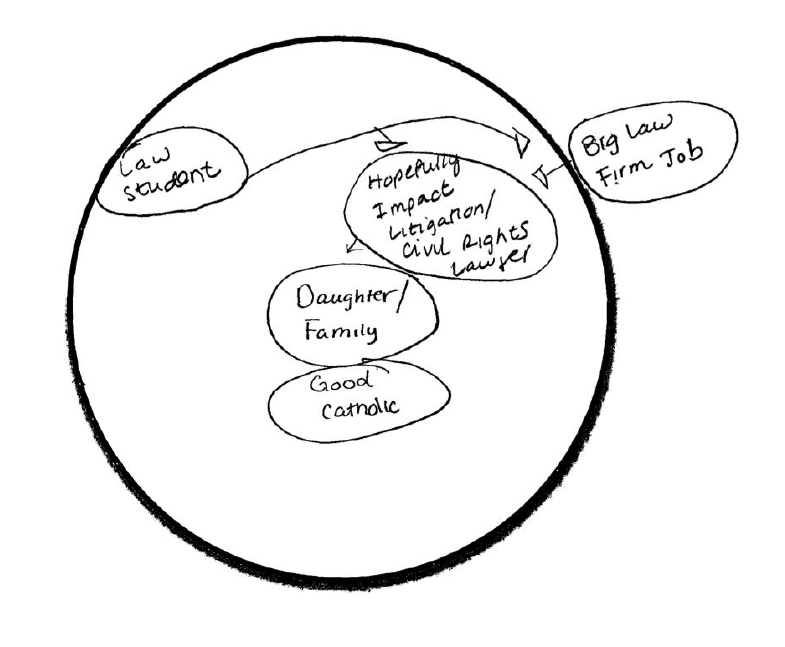
In their first year of law school, drifting respondents tended to place the lawyer role in a central cluster. In their second year, after they had accepted internship offers with large firms, they tended to place the lawyer role on the periphery. This suggests that between the first and second year interviews, drifting respondents generally transitioned from an integrated, cause-lawyering conception of lawyer identity to an instrumentalized conception fraught with moral and psychological role distancing and feelings of fraudulence. With respect to the law student role, drifting respondents experienced substantial distancing in both years, similar to the GPI path, as they described a disjuncture between their initial political motivations for attending law school and the decontextualized and bifurcated nature of lawyering presented in legal education. Figure 7 displays an aggregate identity map for the drifting path.
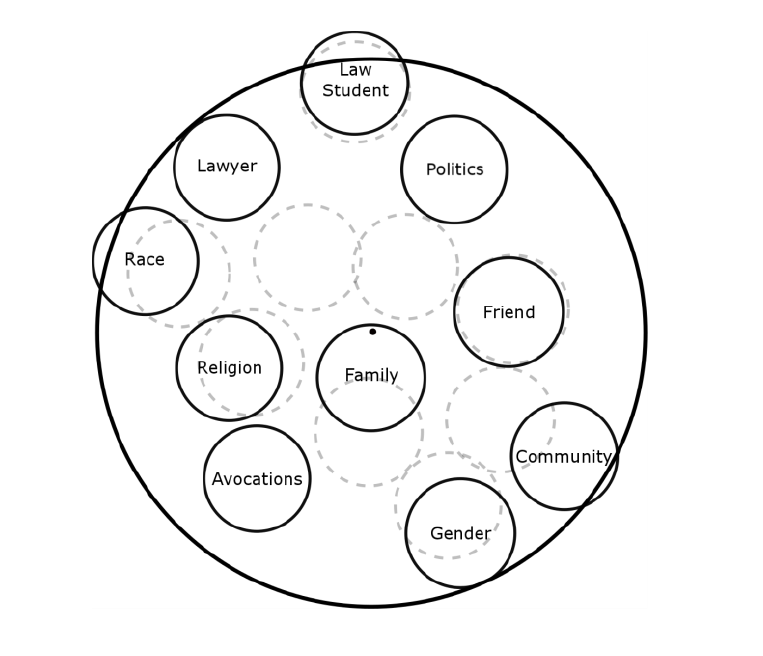
Nearly every drifting-path respondent reported that they intended their positions in the large-firm sector to be temporary stints, after which they hoped to return to GPI practice. While accounts of temporariness were also prominent in the corporate path, those respondents were primarily concerned with work-life balance and mobility in their future careers. In the drifting path, accounts of temporariness were often laden with moral distancing and role playing as respondents worried that they had “sold out” by choosing to work for large firms. A second-year drifting respondent explained to me:
The firm where I will be working] defends the biggest companies…and they’re being sued by the public-interest organizations that I might have worked at…I know it’s all part of the legal system and everyone deserve a defense, but I also kind of feel like I switched sides…like I have to actively fight for the wrong side now.
Drifting respondents generally transitioned from an integrated conception of lawyer identity to an instrumentalized conception fraught with moral and psychological role distancing and feelings of fraudulence.
Feelings of fraudulence were particularly salient in drifting students’ accounts of the law firm hiring program hosted by the law school, which occurs at the end of the first summer. In these job interviews, drifting students often present themselves in a new light while struggling to conceal a great degree of ambivalence. A second-year drifting path respondent described his efforts to construct new “interview answers” to questions about his personal and professional motivations for joining a big firm.
I have to shape my life experiences into a narrative arc . . . and tell my life as a story with a beginning, middle, and end. And the conclusion has to be ‘why I want to be a lawyer,’ or ‘why I wanted to go to law school,’ or ‘why I want to work for a firm,’ or ‘for this firm.’ And that seems totally false.
Many drifting respondents shared this view that the self-narratives they presented in job interviews were markedly different from their “true” self-narratives, which retained public-interest ideals. The sociologist Goffman illuminates how these multiple self-conceptions can be maintained through meticulous “audience segregation” and by concealing motives that are incompatible with an “idealized” version of the role. For many drifting students, cultivating this idealized impression required going to great lengths to avoid revealing their reservations about working in large firms, especially when interviewers inquired about the public-interest orientation suggested by their resumes. These respondents typically rehearsed their interview approach with the law school’s career-development staff and were coached to spin their public-interest experience as training for a career in corporate law.
I bombed every interview. Until I realized that you have to lie.
One second-year drifting student told me that when she was questioned about her public-interest background, she would equivocate by answering a different question than the one asked—what she termed, “pulling a Sarah Palin.” Many drifting students resorted to outright deception. “I bombed every interview,” one second-year drifting respondent told me, “Until I realized that you have to lie.” The respondent credited his use of deception for his eventual success in securing a summer associate position in a large firm:
When I was talking to [law firm interviewers] I told them I was interested in class actions, which is true…but I told them I was interested in them because I saw it as a legal mechanism that is often stretched beyond its proper scope…If I told them what I believe, I definitely don’t think I would have gotten a job. I think [that] before I had just been figuring out ways not to tell [interviewers] what I really thought. And then I shifted to affirmatively telling them lies. So I guess that helps. I guess that’s what it takes.
Three job paths, three professional identities
The evidence presented above suggests that experiences of professional role distancing varies according to students’ job-path decisions during law school. Among the students I interviewed, GPI-path respondents tended to report a relatively stable, central, and clustered conception of professional identity, integrating political, racial, religious, and gender roles. Corporate-path respondents tended to report an increasingly distant relationship to professional identity. Drifting-path respondents tended to experience a similar distancing with respect to professional identity, while struggling with concerns about fraudulence as they conceived of their enactment of the corporate lawyer role as a temporary and morally suspect performance. These findings are reflected in Figure 8, which provides a side-by-side comparison of aggregate maps by job path with the “law student” and “lawyer” (or “advocate”) roles highlighted.

What should we make of this?
This analysis has examined distancing largely with respect to anticipated lawyer roles. Expanding this inquiry beyond the early stages of lawyers’ careers would illuminate the extent to which this distancing may reflect initial discomfort in the professional role, which may subside over time (see “Professional Identity in Practice”). In the limited follow-up interviews I conducted with young lawyers, I found evidence that the association between practice setting and conceptions of professional identity may continue into the first years after graduation. Notably, the students whose corporate job offers were rescinded before graduation (due to the recession) often returned to public-interest practice and a more proximate conception of professional identity. These accounts suggest a possible amendment to our understanding of professional socialization.
Thus, while legal education influences the shaping of professional selves, it seems that these selves can be quickly modified when students and new lawyers change practice settings. Such flexibility in early-career professional identity is perhaps well adapted to the widespread job mobility found among new lawyers. The After the JD study reveals that lawyers change jobs and even sectors frequently in their first years of practice.
Moreover, the analysis raises important questions regarding the effects of role distancing or embracing. Most importantly, is role distancing harmful for young associates? On first glance, distancing from a professional role, such as lawyer, may carry a presumption of malignance. Much of the normative literature on lawyer identity supports this by detailing the moral sacrifices required under the standard bifurcated conception of lawyer identity. However, professional role distancing is not, a priori, harmful. Instead, role distancing is a continually constitutive practice by which we produce a cohesive sense of self by arranging roles on a spectrum of identification. Conceiving of some roles as relatively distant can theoretically yield benefits as well as harms. Professional role distancing among large-firm associates may provide a mechanism for avoiding identity crisis when these lawyers leave Big Law, as occurs in large numbers over the first several years of practice.
Indeed, it is important to acknowledge that individuals may actually aspire to limit the degree to which they embrace their professional identity. Previous research has warned that excessive professional role integration can pose hazards to young professionals. This point is corroborated by the corporate-path respondents cited above who emphasized work-life balance and parenting as reasons to locate the lawyer role outside of their central clusters, for fear that their professional lives would “subsume” their identities. These concerns can be found in research across the professions, particularly where individuals pursue their careers as a “calling.”
Role distancing in comparison: Over-identification in the priesthood
Glen Kreiner, Elaine Hollensbe, and Mathew Sheeps 2006 study of identity work among priests underscores the “pitfalls of high role and identity infusion” as the “demands of the social identities infringe upon the uniqueness of the personal identity.” Priests often reported over-identification: “[Being a priest is] just part and parcel of every cell in my body. I’m a dad. I’m a husband. I’m an outdoors man. I’m a priest…It all goes together…You are a priest whether you have your collar on or not.” This theme was further evidenced by priests who reported wearing their collars at home and carrying the title “Father” into their personal relationships.
Over the course of their careers, many of these priests seemed to push back against the “greedy” and “intrusive” nature of the occupational role. One priest explained: “I have backed off of that over-identification to the point where I feel like I have a reasonable distance from it.” Other priests expressed the related concern, much like the drifting law students in the present study, that they lacked “identity transparency.” They believed that “their ‘true selves’ often couldn’t be revealed to parishioners or the general public because those true selves were incongruent with what a priest should do, say, or be.”
For corporate-path respondents, reduced identification with the professional role often appeared to be a benign experience, as they reported few concerns with fraudulence and moral reservations. However, this distancing may raise external concerns for clients, the profession, and society. In “Lawyers as Professionals and as Citizens: Key Roles and Responsibilities in the 21st Century,” co-authors Ben W. Heineman Jr., William F. Lee, and David B. Wilkins argue that lawyers in the current “period of stress and transition” need both “core legal competencies but also complementary competencies involving broad vision, knowledge, and organizational skills.”
The authors suggest that lawyers in the amoral mold may fall short in serving all three of their fundamental roles as “expert technicians, wise counselors, and effective leaders.” This viewpoint suggests an expectation within the corporate practice sector that new lawyers should be personally invested in their work. However, the bifurcated and instrumentalized account of professional identity found among many corporate lawyers-in-training in my sample may not fit with these expectations.
Furthermore, conceptions of professional identity that separate one’s work role from political, racial, family, and gender roles may discourage lawyers’ enthusiasm for the civic dimension of professionalism. Given that large firms’ pro bono contributions and financial support of public-interest organizations have become increasingly vital to the provision of public interest services, the legal profession’s commitment to social justice causes has come to rely substantially on corporate lawyers. Therefore, it may be necessary to challenge the hard distinction between public interest and corporate practice, particularly in the exaggerated accounts of differentiation offered by some first-year law students as they begin to shape their perceptions of professional identity (see “Supporting Story A”).
A broader discussion of these issues should also more carefully consider generational context. Research from the 1950s and 1960s emphasized the powerful contribution that one’s life-long occupation made to self-construction. However, more recent studies suggest that these descriptions no longer apply. The increased job mobility (and precarity) associated with the rise of “liquid modernity” has led to a diminished capacity for one’s professional role to provide a stable, long-term anchor for the self. Instead, as sociologist Zygmunt Bauman argues, contemporary workers emphasize flexibility and prefer to “keep each current identity temporary, to embrace it lightly, to make sure that it will fall away once the arms are open to embrace its new, brighter, or just untested replacement”.
Drawing on the findings of the present study, we may hypothesize that some new professionals demand greater autonomy in their professional roles, particularly insofar as they consider jobs as sequential steps toward a self-expressive vocation. In contrast, other new professionals may expect less self-fulfillment and agency within their occupational roles as they come to view each temporary position as distinct from and supportive of more deeply-rooted identities (such as family roles). The corporate-bound law students discussed above tend to illustrate the reduced-agency trend. When these respondents described exit options from large firms, they seemed to strongly value the liquidity and lightness of their corporate lawyer identities. Drifting respondents often shared this emphasis on exit options and mobility, but worried that their large-firm role performances could become ingrained in their self-concepts. For GPI respondents, a particular job may be viewed as a lightly embraced stint, but the overall career identification as a “public interest advocate” (or a similar label) tended to be aspirationally described as a life-long, deeply constitutive role.
Try it for yourself: Identity mapping at home
Step 1. List the roles that you enact in your daily life. You may include any roles that occur to you, just make sure that you include your identity as a lawyer.
__________________________________________________
__________________________________________________
__________________________________________________
__________________________________________________
__________________________________________________
__________________________________________________
Step 2. The circle below represents your identity. Draw and label small circles representing each role you listed in Step 1, and place these roles close to center of your map if they are particularly important to your sense of identity, and further from the center if they are less important.




